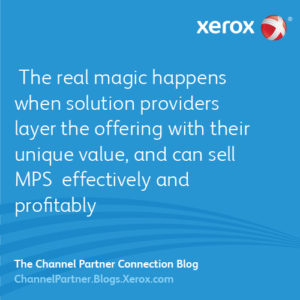
Putting together the right hardware and software is only the first step in developing a successful managed services practice. The real magic happens when solution providers layer the offering with their unique value, and can sell Managed Print Services (MPS) effectively and profitably.
To maximize the MPS opportunity and really drive sales, channel partners need to understand the needs and concerns of potential clients; to look at the engagement the way the customers themselves approach the issue.
For those entrenched in IT services, much of this comes from the deep knowledge service providers have about their clients’ systems and organizations. Still, there are some basics that should form the foundation of any good MPS sales effort:
Determine cost models and scale
Before settling on a model like pay-per-page, -per-device or -per-client, factor in the necessary assets – people, consumables, devices, etc. – to determine what you can reasonably offer. Steer clear of so-called fixed, monthly unlimited-use arrangements. In terms of scale, figure out how small you’re willing to go, as SMB clients with limited printing needs may require more attention than the contract will be worth in the long term.
Develop broad and deep assessment capabilities
Effective MPS engagements must be built on detailed assessments that take a total organizational view of all print-related needs and processes to maximize opportunities for cost savings and productivity improvements over the life of the contract. The solution providers must be prepared to offer a full document assessment that analyzes print use, plus a document workflow assessment that identifies business process improvement opportunities.
Quantify and demonstrate integrated business and process knowledge
Because managed print is incorporating mobile and remote assets, clients are looking to a single partner with proven abilities in IT, print and business process services. This is particularly true in vertical industries and specialized line-of-business offerings like those tailored to human resources, finance and legal departments. Be prepared to show how MPS not only leverage existing investments in hardware, but can seamlessly integrate with business processes to improve organization performance.
Bake security into current and future mobile print initiatives
The bring-your-own device trend has opened a realm of mobile printing possibilities, but it can introduce worrisome security vulnerabilities in the form of untested or unsecure consumer mobile printing software. The goal of a mature MPS offering is to implement an enterprise mobile printing platform that lets employees and guests print securely from any mobile device to any device. Even if the client isn’t fully engaged in BYOD, it’s a safe bet they will be soon. Adopting secure mobile printing capabilities that support existing requirements and are suited for broader mobile adoption in the future is vital.
Demonstrate flexibility
Businesses are always adapting to market changes, and their MPS contracts should never be an impediment to this growth. Today’s agreements need to be adaptable with regards to offering, terms, staffing and location. Build in the ability to incorporate new solutions like cloud and software-as-a-service-based technologies, open standards, business analytics and standards-based business process methodologies to ensure objectives can be met through the life of the engagement.
Offer mature service level agreements
Here’s where partners can really drive home the value proposition of their MPS offerings. SLAs need to be flexible and well-balanced on risk and cost, and clearly measurable with built-in analytics to fine-tune the print management engagement for improvement and an eye toward future needs.
Subscribe to the Channel Partner Connection and receive email updates when we publish a new article.
(This article was first published on IT:Connect & Expand, a Channelnomics blog presented by Xerox for managed service providers.)



